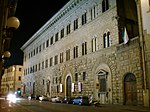Orsanmichele

Orsanmichele (pronounced [orsammiˈkɛːle]; "Kitchen Garden of St. Michael", from the Tuscan contraction of the Italian word orto) is a church in the Italian city of Florence. The building was constructed on the site of the kitchen garden of the monastery of San Michele which no longer exists. Located on the Via Calzaiuoli in Florence, the church was originally built as a grain market in 1337 by Francesco Talenti, Neri di Fioravante, and Benci di Cione. Between 1380 and 1404, it was converted into a church used as the chapel of Florence's powerful craft and trade guilds. On the ground floor of the square building are the 13th-century arches that originally formed the loggia of the grain market. The second floor was devoted to offices, while the third housed one of the city's municipal grain storehouses, maintained to withstand famine or siege. Late in the 14th century, the guilds were charged by the city to commission statues of their patron saints to embellish the facades of the church. The sculptures seen today are copies, the originals having been removed to museums (see below).
Excerpt from the Wikipedia article Orsanmichele (License: CC BY-SA 3.0, Authors, Images).Orsanmichele
Via dei Lamberti, Florence Quartiere 1
Geographical coordinates (GPS) Address External links Nearby Places Show on map
Geographical coordinates (GPS)
| Latitude | Longitude |
|---|---|
| N 43.770758333333 ° | E 11.255169444444 ° |
Address
Chiesa di Orsanmichele
Via dei Lamberti
50122 Florence, Quartiere 1
Tuscany, Italy
Open on Google Maps








